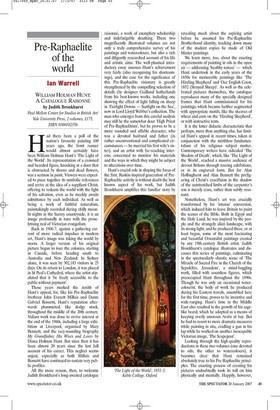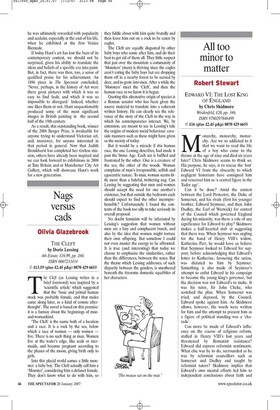Pre-Raphaelite of the world
Ian Warrell WILLIAM HOLMAN HUNT: A CATALOGUE RAISONNE by Judith Bronkhurst Paul Mellon Center for Studies in British Art! Yale University Press, 2 volumes, £175, ISBN 0300102356 Had there been a poll of the nation's favourite painting 100 years ago, the front runner would almost certainly have been William Holman Hunt's 'The Light of the World'. Its representation of a crowned and bearded figure, knocking at a door that is obstructed by thorns and dead flowers, was a sermon in paint. Viewers were expected to piece together its symbolic references and arrive at the idea of a suppliant Christ, offering to redeem the world with the light of his salvation, even as he meekly awaits admittance by each individual. As well as being a work of faithful naturalism, painstakingly recorded during chilly moonlit nights in the Surrey countryside, it is an image profoundly in tune with the proselytising zeal of Victorian evangelism.
Back in 1906-7, against a gathering current of more radical impulses in modern art, Hunt's image was taking the world by storm. A larger version of his original picture began to tour the colonies, starting in Canada, before heading south to Australia and New Zealand. In Sydney alone, it was seen by 302,183 visitors in 25 days. On its return to London, it was placed in St Paul's Cathedral, where the artist stipulated that it 'be freely accessible to the public without payment'.
Those years marked the zenith of Hunt's appeal, for, like his Pre-Raphaelite brethren John Everett Millais and Dante Gabriel Rossetti, Hunt's reputation afterwards plummeted, like dodgy stock, throughout the middle of the 20th century. Valiant work was done to revive interest at the end of the 1960s, including a large exhibition at Liverpool, organised by Mary Bennett, and the racy-sounding biography My Grandfather, His Wives and Loves by Diana Holman Hunt. But since then it has been almost 20 years since the last full account of his career. This neglect seems unjust, especially as both Millais and Rossetti have continued to sustain very public profiles.
All the more reason, then, to welcome Judith Bronkhurst's long-awaited catalogue raisonne, a work of exemplary scholarship and indefatigable sleuthing. These two magnificently illustrated volumes are not only a truly comprehensive survey of his paintings and watercolours, but also a rich and diligently researched account of his life and artistic aims. The well-planned introductory essay assesses Hunt's achievement very fairly (also recognising his shortcomings), and the case for the significance of this Pre-Raphaelite visionary is greatly strengthened by the compelling selection of details (by designer Guilland Sutherland) from his best-known works, including one showing the effect of light falling on sheep in `Fairlight Downs — Sunlight on the Sea', now in Lord Lloyd Webber's collection. The man who emerges from this careful analysis may still be the somewhat dour 'High Priest of Pre-Raphaelitism', but he proves to be a more rounded and affable character, who was a devoted husband and father (in rather unconventional and complicated circumstances — he married his first wife's sister), and an artist with far-reaching interests, concerned to monitor his materials and the ways in which they might be subject to alterations over time.
Hunt's crucial role in shaping the focus of the first, Ruskin-inspired generation of PreRaphaelite activity is without doubt the best known aspect of his work, but Judith Bronkhurst amplifies this familiar story by revealing much about the aspiring artist before he assumed his Pre-Raphaelite Brotherhood identity, tracking down many of the student copies he made of Old Master paintings.
We learn more, too, about the exacting requirements of painting in oils in the open air — addressing 'healthy nature' — which Hunt undertook in the early years of the 1850s for memorable paintings like 'The Hireling Shepherd' and 'Our English Coast, 1852 (Strayed Sheep)'. As well as the celebrated pictures themselves, the catalogue reproduces many of the specially designed frames that Hunt commissioned for his paintings, which became further augmented with appropriate motifs, like the sheaves of wheat and corn on the 'Hireling Shepherd', or with instructive texts.
It is the latter didactic characteristic that perhaps, more than anything else, has limited Hunt's appeal in recent times, taken in conjunction with the mirthless fundamentalism of his religious subject matter. Contemporary writers have ridiculed 'The Shadow of Death', which, like 'The Light of the World', reached a massive audience of devout Britons through touring exhibitions, or in its engraved form. But for Alan Hollinghurst and Alan Bennett the prefiguring of Christ's crucifixion in the shadow of the outstretched limbs of the carpenter's son is merely crass, rather than subtly resonant.
Nonetheless, Hunt's art was crucially transformed by his 'intense' conversion, which induced him to leave Britain to paint the scenes of the Bible. Both in Egypt and the Holy Land, he was inspired by the people and the strangely alien landscape, with its strong light, and he produced there, or at least began, some of the most fascinating and beautiful Orientalist paintings created by any 19th-century British artist. Judith Bronkhurst's catalogue illustrates and discusses this series of paintings, culminating in the spectacularly chaotic scene of 'The Miracle of Sacred Fire in the Church of the Sepulchre, Jerusalem', a mind-boggling work, filled with countless figures, which preoccupied Hunt throughout the 1890s. Though he was only an occasional watercolourist, the body of work he produced during his Eastern travels, assembled here for the first time, proves to be inventive and wide-ranging. Hunt's time in the Middle East also resulted in the growth of his sagelike beard, which he adopted as a means of keeping overly amorous Arabs at bay. But he had to resort to more dramatic measures while painting in situ, cradling a gun in his lap while he worked on another inescapable Victorian image, 'The Scapegoat'.
Looking through the high-quality reproductions in these two volumes (one devoted to oils; the other to watercolours), it becomes clear that Hunt remained absolutely true to his Pre-Raphaelite principles. The exacting process of creating his pictures undoubtedly took its toll on him physically and mentally. Happily, however, he was ultimately rewarded with popularity and acclaim, especially at the end of his life, when he exhibited at the first Venice Biennale.
If today Hunt's art has lost the buzz of its contemporary context, we should not be surprised, given his ability to translate the ideas and beliefs of a specific era into paint. But, in fact, there was then, too, a sense of qualified praise for his achievement. An 1886 piece in The Spectator concluded, 'Never, perhaps, in the history of Art were there great pictures with which it was so easy to find fault, and which it was so impossible to disregard.' Indeed, whether one likes them or not, Hunt unquestionably produced some of the most significant images in British painting in the second half of the 19th century.
As a result, this outstanding book, winner of the 2006 Berger Prize, is invaluable for anyone trying to understand Victorian art, and, moreover, for anyone interested in that period in general. Now that Judith Bronkhurst has completed her tireless mission, others have already been inspired and we can look forward to exhibitions in 2008 at Tate Britain and at Manchester City Art Gallery, which will showcase Hunt's work for a new generation.






















































 Previous page
Previous page